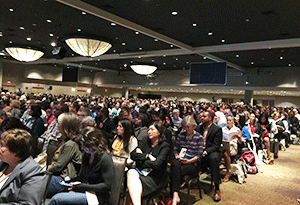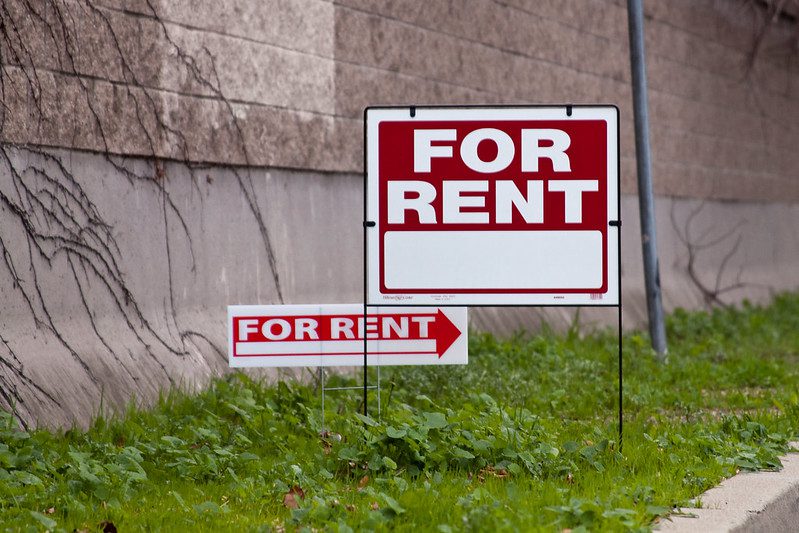
Audience at PolicyLink’s 2015 Equity Summit. Photo courtesy of Shelterforce
“Place matters, but place changes,” University of Southern California professor Manuel Pastor observed at the opening plenary at PolicyLink’s 5th Equity Summit, held this week in Los Angeles. This can be seen as both a warning and a hope—and it led to some great discussions about changing places and what can be done to bend those changes in the direction of more equity.
The “Race, Place, and Equity” panel opened with researcher Raj Chetty giving an overview on the dramatic difference place makes for young children (see my musings about what we are measuring on that front), setting the stage for panelists to call for changes in the factors that make some metropolitan areas so much lower opportunity than others. “This trend of there being no relationship between productivity in the country and how people are doing has got to end,” said Thomas Steyer, president of NextGen Climate.
However, William Spriggs, chief economist of the AFL-CIO, cautioned the audience against allowing the acknowledgment of the importance of place to mean that we fetishize local solutions. Noting that the region Chetty’s research shows is the worst for social mobility are essentially the former Confederacy, as well as “right-to-work,” low-union density states with minimum wages set at the federal minimum and a history (and present) of active voter suppression, Spriggs argued that there comes a time for federal intervention. Local solutions have to produce results. “Experiments are great, but Mississippi, you’ve had 100 years to experiment,” he said, “And you’re getting an F.”
Relatedly, Spriggs noted that we have to be very careful not to allow acknowledging the effect of place and segregation to slip into asking “what’s wrong with black people?” (I think it is worth noting that I saw flash by in one of Chetty’s slides that Prince Georges County in Maryland, a wealthy county that is 64.7 percent black and only 14.2 percent non-Hispanic white, did comparatively well in his rankings of mobility.)
All the panelists spoke in some way about what La June Montgomery Tabron, president and CEO of the W.K. Kellogg Foundation, called the “growing business case for racial equity,” echoing the theme of 2011’s Equity Summit, “equity is the superior growth model.”
But while we are focusing on increasing the ability of places to change for the better, we have to remember that they don’t always change for the better, and when they do, those changes don’t always benefit the people we want them to benefit.
Improving Places—For Whom?
Gentrification and displacement were, not surprisingly, big themes at this year’s conference. Opening a well-attended forum on displacement, Kenneth Zimmerman of the Open Society Foundations referred to a study done by Governing magazine that found a 20 percent gentrification rate for census tracts in the past decade in the largest 50 cities in the country, a greatly accelerated rate from the previous decade.
It’s important to remember that the phenomenon is still very concentrated in hot-market cities, with more than four times the number of gentrification-eligible census tracts not gentrifying and actually increasing in poverty rate over that time. This frustrates many advocates for the areas not seeing any movement. Still, I think there are many reasons why gentrification catches people’s attention in a different way:
- There’s an added measure of insult to injury when you have made it through the really bad days only to feel that you are going to be pushed out or targeted as a nuisance in your own home when things improve.
- There are resources coming in to gentrifying neighborhoods. Fighting for a share of existing resources is a more tangible fight than demanding resources for a place that is (so far) just being left out.
- And, of course, anyone who has seen a neighborhood given up for lost transition to displacement feels it can happen anywhere, even if it isn’t yet. It’s no more of a stretch to imagine rust belt cities booming again in a few decades than it would have been not long ago to imagine anyone being concerned about displacement pressure in Brooklyn’s East New York neighborhood.
I think we do need to keeping talking about the places that are not yet gentrifying, but also, despite the current concentration, the Governing data actually does show that the gentrification conversation is actually relevant across a much wider range of places than is often assumed. Even in the cities where only a modest percentage of census tracts were gentrifying—places like Omaha, Dallas, Baltimore, Wichita, or Albuquerque—the number of tracts that are gentrifying in nearly all cases has shot up by a factor of 2 to 3 or more in the last decade compared to the one before. There’s a reason it’s on everyone’s tongue. I heard conversations in my recent travels on its effects or anticipated effects on parts of places from Sacramento to Nashville to Lexington.
(For more on why gentrification is even a bigger deal than the Governing study shows, see this excellent post by Josh Ishimatsu.)
The Equity Summit’s displacement forum was opened by Native American poet Bobby Wilson, who noted the appropriateness of this particular topic for native peoples. (Side note: This event had the most visible participation of Native Americans of any conference in the field I’ve attended except for Opportunity Finance Network.) It was sort of surprising that I haven’t heard that connection made before, but it does point out that displacement and forcible removal of one kind or another is a key part of our history from all the way back to before the formal founding of the United States.
In that forum, Dawn Phillips of Causa Justa:Just Cause (after suggesting that if we really care about displacement we leave and go to the Black Lives Matter forum instead) said that her organization had an explicit vision that 30 percent of the housing in Oakland, Calif., be held in public trust as permanently affordable. This fascinated me, since I recently heard that Boulder, Colo., has an official city goal of 10 percent and George McCarthy of the Lincoln Institute of Land Policy recently suggested in our pages that we should as a field be seeking some undetermined sweet spot percentage of permanently affordable units to mitigate the effects of economic cycles.
Obviously there are a million questions to be asked of a goal like that—affordable to whom, how, why that percentage, who gets the units, what’s the specific goal you’re trying to achieve by setting those units aside (economic integration? preventing displacement? cultural preservation?). However, that isn’t a critique of having such a goal. Housing policy gets bogged down in arcane details pretty quickly, and having a clear, simple, direct goal like that strikes me as a really good thing. Maybe it could be a thing to rally around, and bring more people into the discussion around the details from the perspective of “this is a thing we’re going to do, we’re just talking about how.”
For other solutions brainstormed by the audience at that forum, see this Storify collection.
(Photo credit: Audience at PolicyLink’s 2015 Equity Summit, courtesy of Shelterforce)






Sorry, but I have to call BS.
Especially on William Spriggs’ analysis which is nothing but pure, unadulterated politics.
I’m no history scholar, but I’ve looked at the EOP’s display and I’m pretty sure that places like Chicago, Gary Indiana, The Bronx, Camden New Jersey, Oakland California, the District of Columbia and New Haven Connecticut were NOT “essentially the old Confederacy,” not even Baltimore, even though it’s south of the Mason Dixon line. Oh sure, there are plenty of poor performers in The South, but Mission South Dakota and Browning Montana are about as far from Dixie as you can get.
No, you can’t blame those nasty ol’ Confederates for this.
And, while we’re at it, most of those areas are also the exact OPPOSITE of “right-to-work, low-union density.”
Do these distinctions really matter in a discussion of place and its impact on poverty?
Of course.
If you’re associating POVERTY with PLACE, then the question becomes one of POLICY.
What are the policies… of those places?
Obviously it’s not the slaveholding plantation owners or the Klan.
No it’s not the absence of unions. Most of those areas have a long history of active organization.
SO…
once you take the logical, and painfully obvious, step of ruling out some knee jerk usual suspects and scapegoats, what have the policies been that have preceded the lousy conditions we see in so many of these places today?
Once we start a serious discussion of policy, unencumbered by some of the obvious prejudices displayed here, perhaps we can actually make some progress.
Blaming the usual boogeymen is the first step back into business as usual, and we can see in our cities right now how well that has worked.
Chris, You are totally right that being part of the former Confederacy is not the only thing that causes poor mobility. Not at all, and I doubt Spriggs meant that either.
But if you look at the map in the center bottom of Raj’s home page, you can’t deny the overwhelming concentration of dark red in the Southeast. It’s very dramatic. (https://www.rajchetty.com). Since he finds that segregation and income inequality are two of the big predictors of lack of mobility, it’s actually perfectly reasonable that a place with a history of Jim Crow and forbidding unionizing (both of which are in fact policies, as you suggest we focus on) would show these results. That’s not knee jerk, it’s following the lead of research.
Are they the only relevant policies? Certainly not.
(I’ve changed “the areas” to “the region” in the post to make the point less misleading.)